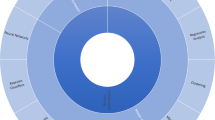Abstract
Building recommender systems (RSs) has attracted considerable attention in the recent years. The main problem with these systems lies in those items for which we have little information and which cause incorrect predictions. One accredited solution involves using the items’ content information to improve these recommendations, but this cannot be applied in situations where the content information is unavailable. In this paper we present a novel idea to deal with this problem, using only the available users’ ratings. The objective is to use all possible information in the dataset to improve recommendations made with little information. For this purpose we will use what we call second-hand information: in the recommendation process, when a similar user has not rated the target item, we will guess his/her preferences using the information available. This idea is independent from the RS used and, in order to test it, we will employ two different collaborative RS. The results obtained confirm the soundness of our proposal.






Similar content being viewed by others
Explore related subjects
Discover the latest articles, news and stories from top researchers in related subjects.Notes
To clarify, we show a recursive version of the algorithm, but the implemented version is sequential.
This is one of the differences from the reference model presented in de Campos et al. (2008), i.e., the inclusion of rating 0 in the performance of the system.
We have evaluated the system with only positive Pearson correlation and we have obtained worst results than using absolute value.
Note that in this mode we do not show the success ratio as error measure because the predicted value is not an ordinal value.
In order to test this fact we have also included all the ratings but it worsen the performance of the systems.
References
Ali K, van Stam W (2004) Tivo: making show recommendations using a distributed collaborative filtering architecture. In: KDD ’04: Proceedings of the tenth ACM SIGKDD international conference on knowledge discovery and data mining. ACM, New York, pp 394–401. doi:10.1145/1014052.1014097
Belkin NJ, Croft WB (1992) Information filtering and information retrieval: two sides of the same coin? Commun ACM 35(12):29–38. doi:10.1145/138859.138861
Breese JS, Heckerman D, Kadie C (1998) Empirical analysis of predictive algorithms for collaborative filtering. In: 14th conference on uncertainty in artificial intelligence, pp 43–52. http://citeseer.ist.psu.edu/breese98empirical.html
Burke R (2002) Hybrid recommender systems: survey and experiments. User Model User Adapted Interact 12(4):331–370
de Campos LM, Fernández-Luna JM, Huete JF (2006) A Bayesian network approach to hybrid recommending systems. In: Eleventh international conference of information processing and management of uncertainty in knowledge-based systems. Paris, France, pp 2158–2165
de Campos LM, Fernández-Luna JM, Huete JF (2008) A collaborative recommender system based on probabilistic inference from fuzzy observations. Fuzzy Sets Syst. 159(12):1554–1576. doi:10.1016/j.fss.2008.01.016
Degemmis M, Lops P, Semeraro G (2007) A content-collaborative recommender that exploits wordnet-based user profiles for neighborhood formation. User Model User Adapted Interact 17(3):217–255. 10.1007/s11257-006-9023-4
Han S, Chee S, Han J, Wang K (2001) Rectree: an efficient collaborative filtering method. In: Lecture Notes in Computer Science: Data Warehousing and Knowledge Discovery, pp 141–151
Herlocker JL, Konstan JA, Borchers A, Riedl J (1999) An algorithmic framework for performing collaborative filtering. In: SIGIR ’99: Proceedings of the 22nd annual international ACM SIGIR conference on research and development in information retrieval. ACM, New York, pp 230–237. 10.1145/312624.312682
Hofmann T (2004) Latent semantic models for collaborative ltering. ACM Trans Inf Syst 22(1):89–115
Hofmann T, Puzicha J (1998) Latent class models for collaborative filtering. In: 16th international joint conference on artifical intelligence. Stockholm, Sweden, pp 688–693
Kangas S (2002) Collaborative filtering and recommendation systems. In: VTT information technology
Konstan JA, Miller BN, Maltz D, Herlocker JL, Gordon LR, Riedl J (1997) GroupLens: applying collaborative filtering to Usenet news. Commun ACM 40(3):77–87. http://citeseer.ist.psu.edu/konstan97grouplens.html
Marlin B (2004) Collaborative filtering: a machine learning perspective. University of Toronto
Marlin B (2003) Modeling user rating profiles for collaborative filtering. In: NIPS*17. MIT Press, Cambridge
Melville P, Mooney RJ, Nagarajan R (2001) Content-boosted collaborative filtering. In: Proceedings of the 2001 SIGIR workshop on recommender systems
Miyahara K, Pazzani MJ (2000) Collaborative filtering with the simple bayesian classifier. In: Pacific Rim International conference on artificial intelligence, pp 679–689. http://citeseer.ist.psu.edu/miyahara00collaborative.html
OConnor M, Herlocker J (1999) Clustering items for collaborative ltering. In: ACM SIGIR 99 workshop on recommender systems: algorithms and evaluation
Popescul A, Ungar L, Pennock D, Lawrence S (2001) Probabilistic models for unified collaborative and content-based recommendation in sparse-data environments. In: 17th conference on uncertainty in artificial intelligence. Seattle, Washington, pp 437–444. http://citeseer.ist.psu.edu/popescul01probabilistic.html
Resnick P, Varian HR (1997) Recommender systems. Commun ACM 40(3):56–58. 10.1145/245108.245121
Robles V, Larrañaga P, Peña J, Marbán O, Crespo J, Pérez M (2003) Collaborative filtering using interval estimation naive bayes. In: Lecture Notes in Artificial Intelligence: Advances in Web Intelligence, pp 46–53
Su X, Khoshgoftaar TM, Zhu X, Greiner R (2008) Imputation-boosted collaborative filtering using machine learning classifiers. In: SAC ’08: Proceedings of the 2008 ACM symposium on applied computing. ACM, New York, pp 949–950.10.1145/1363686.1363903
Acknowledgments
This study has been jointly supported by the Spanish Ministerio de Educación y Ciencia under the projects TIN2005-02516 and TIN2008-06566-C04-01, and the research program Consolider Ingenio 2010 under the project CSD2007-00018.
Author information
Authors and Affiliations
Corresponding author
Rights and permissions
About this article
Cite this article
de Campos, L.M., Fernández-Luna, J.M., Huete, J.F. et al. Using second-hand information in collaborative recommender systems. Soft Comput 14, 785–798 (2010). https://doi.org/10.1007/s00500-009-0474-5
Published:
Issue Date:
DOI: https://doi.org/10.1007/s00500-009-0474-5




